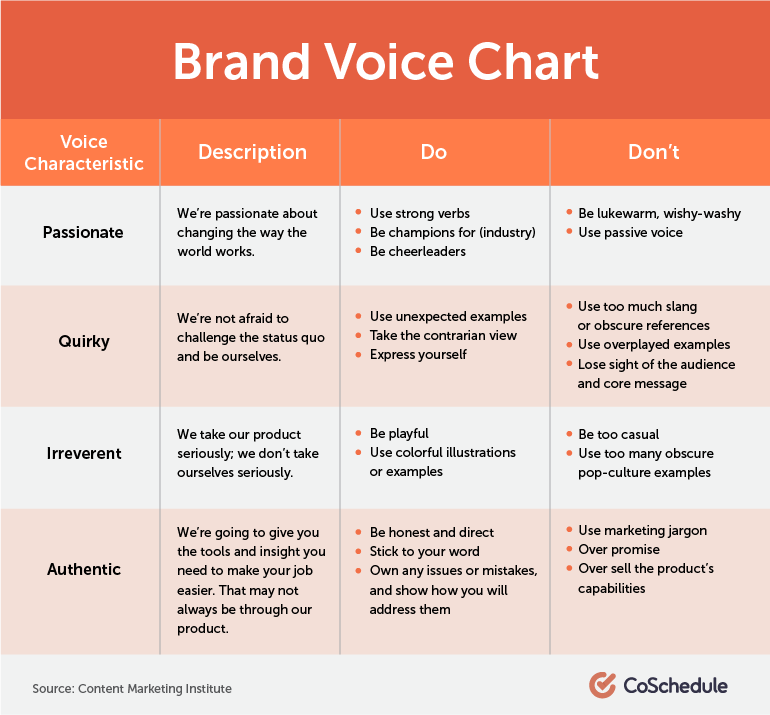One of the best kept secrets of the top 4 valuable brands is their ability to forge a powerful connection with their audience – one that’s helped them to shape conversations, build long lasting loyalty and you can create this for your brand if you get to find your brand voice.
But then, It is not always a walk in the park. In fact, most new brands today do not understand that the brand voice is a very critical aspect of branding that can impact the overall success of any brand.
As someone that’s worked with a diversity of brands, over the years, I find it interesting that brands that get their brand positioning right are always ahead of their peers. And most times, this is regardless of the capital, resources or even years of existence.
So, what exactly is a brand voice?
What is Brand Voice?
Table of Contents
A Brand voice is the personality you embody as a brand, the feeling people get when they come in contact with your content (or products) and the lasting impression that stays with them when they leave.
That’s the simple definition of a brand voice.
Literally, your brand voice revolves around everything you do as a brand. From the words you use in your content, advertising, products etc. to the imagery you’re trying to project as a brand.
A lot of content creators do not see the need to have a distinct brand voice. And out of the few that have seen the need to have one, many are yet to figure out how to create a unique voice for their brand.
If you’re one of the former or the later, then this post is going to show you why you need a brand voice and how to create one that stands out.
Why your Brand Voice is Important
As a content creator, business or brand, getting a distinct voice humanizes your brand. It gives it the human quality that makes it easier for your target audience to relate with your content or product and services at a deeper level.
Also, the consistency and repetitiveness, that comes with a unique brand voice has a way of solidifying your brand in the minds of your audience, helping it to be recognized across board.
Now, besides your brand voice, there’s also the brand tone of voice.
A lot of the times, these two are usually lumped up together but your brand tone of voice also plays a distinct and very significant role when it comes to creating the right effect with a particular piece of content.
Difference Between a Brand Voice and Tone
The major difference between your brand voice and brand tone of voice is that your brand voice represents your unique perspectives and what you stand for. It is more consistent and it’s a part of your permanent brand identity.
On the other hand, your brand tone of voice is most often influenced by the purpose of the particular piece of content.
And for that reason, your brand tone of voice can change, based on the particular kind of content you’re creating and the effect you want to create on your audience.
Specifically, this is what it is…
Voice: Your brand voice is part of your permanent identity as a brand. It is the way you generally communicate with your audience based on what you stand for and usually, it is consistent over a long period of time.
Tone of Voice: Brand tone of voice is the way you (or the way you are perceived to) sound while passing across a particular piece of content, product or information that involves your brand.
Brand tone of voice is usually employed in content creation, advertising or product packaging, in order to create a specific effect on the audience.
Unlike a brand voice that may be well identified across all your content, your brand tone of voice will definitely be influenced by the kind of content you’re creating at a particular time or specific outcome you want to create.
How to Identify your Brand Voice
The following are steps you can use to identify your brand voice…
Review your Brand Goals
Literally, your brand goal is everything you want to achieve as a brand. Many content creators usually create brand goals alongside their business goals before ever creating their first content.
Having a quick review of your brand goals can help you to understand specific steps you can use to create a brand voice that will help shape your goals as well as help you in achieving such goals.
For example, if your overall goal is to come off as an innovative brand, using a certain kind of voice in your content marketing, product design and overall brand positioning can help position you as such, before your audience.
Same thing goes for a brand that wants to sound more authoritative or be recognized as the leader or thought leader in a particular niche. Using your brand goals, you can always shape your brand voice.
Evaluate your Mission Statement
Your mission statement embodies your core values and the reason for your existence, as a brand.
Taking a closer look at your mission statement, you should be able to find out clues on what you stand for and why you’re standing for that.

To get this clearly, take a look at brands like Nike whose mission statement is to “bring inspiration and innovation to every athlete in the world”.
To achieve a brand voice that reflects this mission, Nike continues to create content, products and brand positioning that aims at finding ways to inspire their audience.
If you take a look, you’ll find this in all their marketing.
With a good understanding of your mission statement, you can also use this approach to create a brand voice that is more authentic to your brand.
Analyze your Existing Content
If you already have some existing content, then it’s very possible you have a brand voice, even if that might not necessarily be consistent with the voice you intend to project for your brand.
Taking a critical look at your existing content can help you to understand the way you sound through your content.
With this understanding, you can then fine tune the voice to meet up with the kind of brand voice you really want to be known for or create a new one entirely.
Check out your Competition
Where you can’t figure out the right voice to use for your brand, your competition can give you clues on what’s working in your industry.
To get started, check out successful brand voices in your niche; find out how they sound.
If that adds up to what you want to represent as a brand, you can use that to evolve your own unique brand voice. Remember, you don’t have to sound similar to any brand, unless that’s a part of your overall brand strategy.
Besides the steps mentioned here, you can also research your audience to find out their disposition or the kind of brand voice that will appeal to them.
This research can be done either on a social media forum which has a good number of your ideal audience, a competitor’s page or any other location where you can find data on what works with your target audience.
If what you’re reading is a bit abstract, below is a Brand Voice Chart by CMI and CoSchedule that can also help you in defining your brand voice…

How to find a Brand Tone of Voice
Now that we’ve discussed about how to find your brand voice, I want you to also know that your brand voice cannot be completely fixed without a brand tone of voice because, these two work hand in hand to give you a unique brand identity.
Below are the steps to find your brand tone voice…
Identify your target Audience
Considering that you have now identified your brand goals, the next thing you want to do is to identify your target audience.
You’ll want to ask yourself; who are my target audience. And how can I communicate in a way that will appeal to them, in line with my own brand goals.
Now, let’s bring this into perspective…
In the real world, if you’re making a service provider presentation to the board of directors of a corporate organization like Apple Inc. for instance, there are certain ways you’d want to communicate with them so they can really listen to you.
You won’t want to address the board of directors at Apple Inc. the same way you’d address a collection of undergraduates freshmen at some random university.
This is the same approach you need to take, whenever you’re thinking about creating a unique voice for a particular piece of content.
There are instances where you may not need to use some slangs, pop phrases or sound too formal, depending on the audience you want to target.
To create a more compelling and relatable content, think about your audience and identify a style of communication that sits really well with them based on their needs, experiences and exposure, before creating your content.
Doing this will lead you towards creating the kind of content they can really connect with.
Understand your Audience’s Pain Point
One of the things you must keep in mind is that brands need a brand tone of voice so they can create a specific effect.
Often times, one of the easiest ways to create a strong effect on an audience is to understand their pain points or their specific needs or finding out what they can deeply relate with.
So, you want to ask yourself, what do I want to help my audience achieve with this particular post or positioning? And what’s the best way to achieve this?
Understand that your audience’s primary needs will to a large extent affect your brand tone of voice, at any given time if you really want to create an effect with your preferred voice.
Take for instance, if you want to create better results with your content, you can’t really communicate with a job applicant who’s about losing her accommodation to unpaid rents the same way you’d communicate with a final year college student who’ll be looking for a job in two years’ time.
There are certain adjectives that will work with these groups based on their level of need.
These are the elements that will make them feel like your content is really written for them or capable of addressing their needs.
So, it’s a good thing to have this in mind while finding your brand voice. If you really want to create a meaningful connection with your audience.
Identify the Effect you want to Create
Having a uniform tone of voice for all your content or positioning is usually not realistic. Or even advisable because sometimes, there will be need to sound a certain way so as to create a specific kind of result.
Yes, there should be an overall brand voice associated with your brand. But, there’s need for voice adjustment in some cases.
For example, if you’re creating a copy content that is supposed to lead to a sale (or a sales magnet), you have to sound more authentic and trust worthy so your potential client can have a reason to consider buying from you.
That means, regardless of where your brand voice leans, you’ll need to project honesty and authenticity with the voice you’re using for the particular post or positioning.
With this in mind, if you want to create an effective content, then there’s need to pay attention to the tone of your content, the words, adjectives and phrases you use and generally, the way you sound.
To do this successfully whenever you want to, you will have to tweak your brand voice to meet the particular purpose of the content and the needs of the audience.
Humanize your Content
Now, here’s one thing you should know. Your brand voice will achieve one of the two things for you. It will either create a connection or create a disconnect with your audience.
To create real connections with your audience, you need to humanize your content.
Through your words (for written content) or facial expression, body language and voice (for videos, audio etc.), you need to express your feelings in a way that your audience can actually imagine or feel the experience you’re trying to create.
If you’re producing a video content for instance, you can’t start smiling when you want to create a very serious content. Because it won’t create the right connection with your audience. And no one will take you serious.
Equally, you don’t want to sound over the top if you’re trying to convince someone to subscribe or buy from you. You want to sound as convincing as possible.
These are some of the important elements that needs to come into play, if you want to create the right tone of voice for your brand, as well as the kind of content that stands out with your audience.
Final Words
Finding your brand voice can amplify your brand, reshape your perception and improve your impact as a brand.
With the right kind of brand voice and brand tone of voice, you can create more meaningful content that connects with and inspires your audience to take specific call to action.
While all these are some of the direct results of what a well structured brand voice can do for you, you’ll have to take these steps you just learned, to create a brand voice that will actually work for you and your brand before you get to enjoy these results.
As a parting shot, I want you to understand that creating a brand voice your audience can relate with is one of the first steps that will help you create content your audience can connect with.
As part of our commitment to helping content creators create content that drives results, we have set up Smart Content College to help Creators learn the nitty gritty of Customized Content Marketing that works.
And yes, you can sign up for our content marketing training to learn about content marketing that works, including how to find the right brand voice that will deliver results for your content here.
So now, it’s over to you, what’s your brand voice and if you’ve found one, how’s it been helping your brand? Drop your comments below.

3 Responses
hello sir…
a very nice article, keep up the good work.
Hey Saifuddin, thanks for the feedback. You can always come back to read more interesting stuff right here.
[…] volunteering has become not just a way of giving back to the society but a way of spreading your brand name and getting known for some good […]